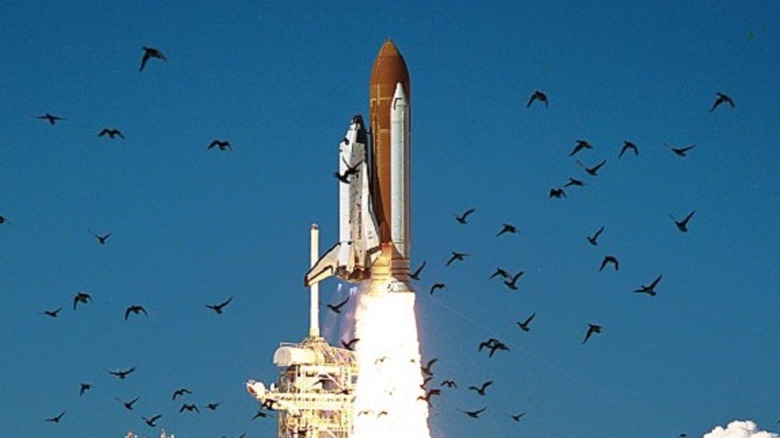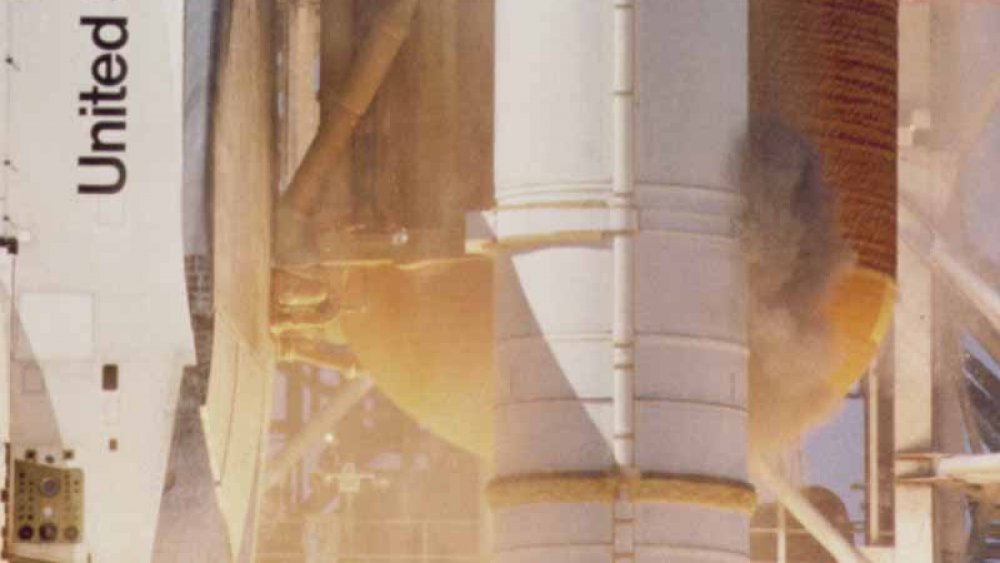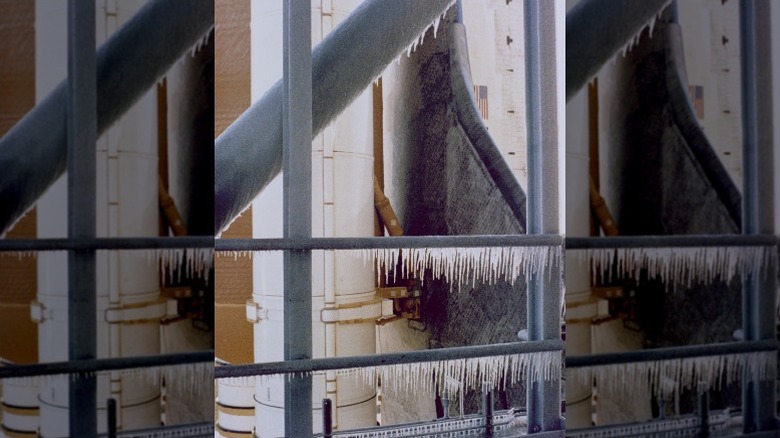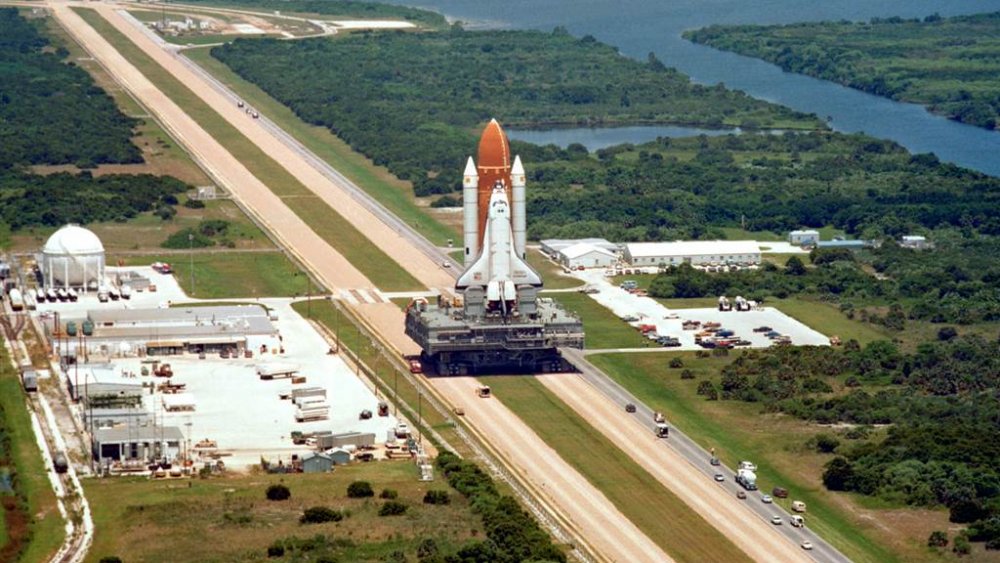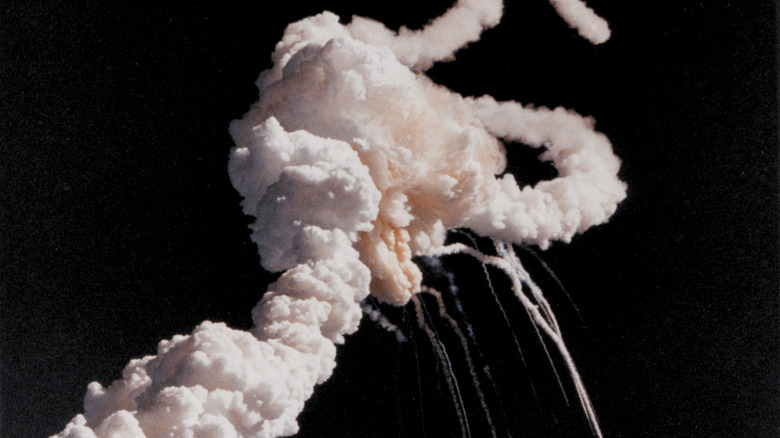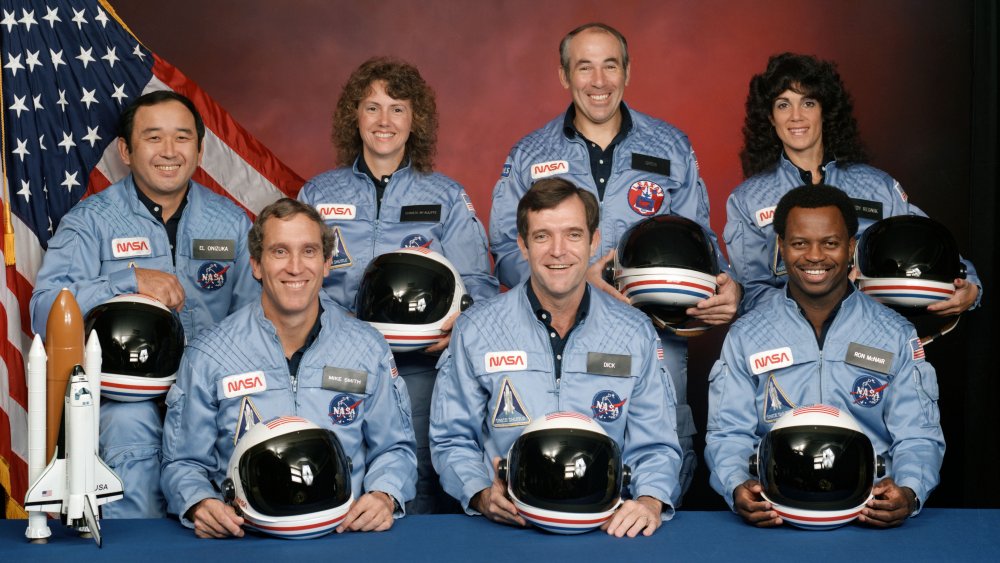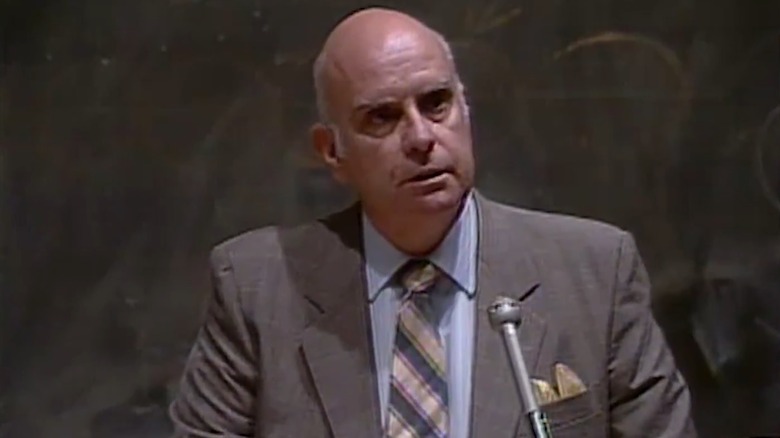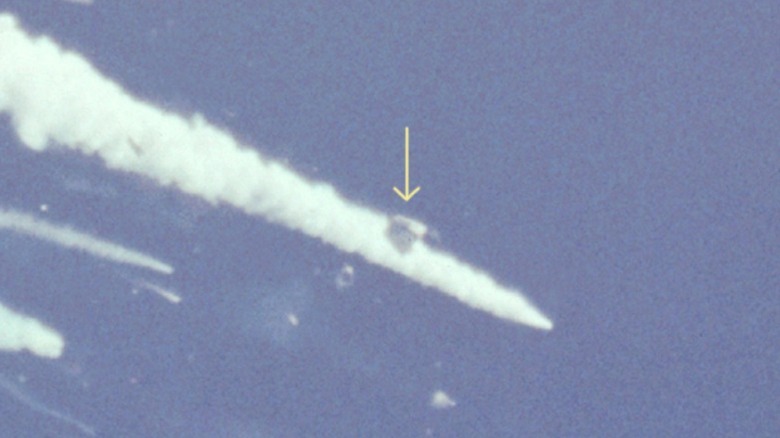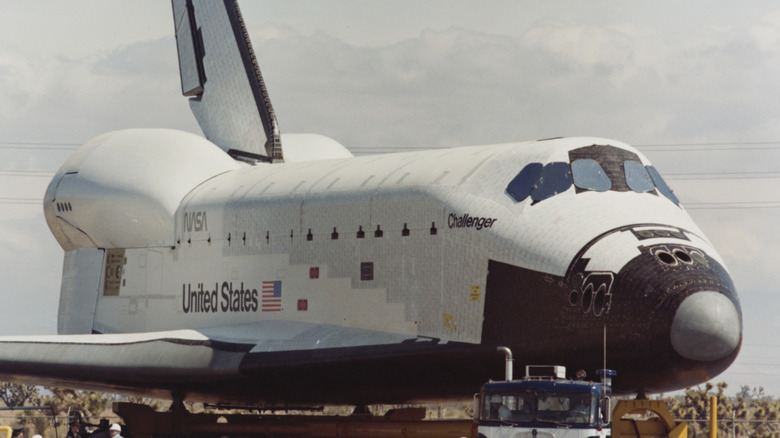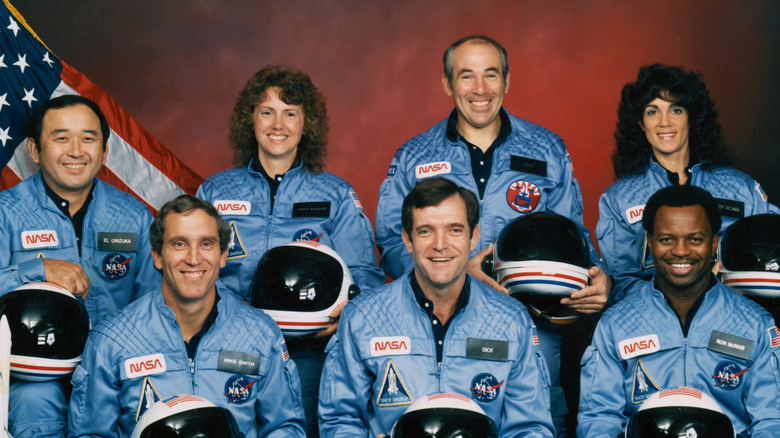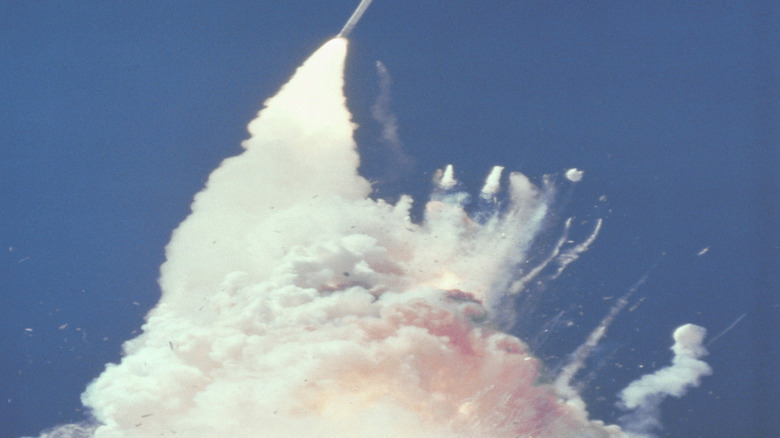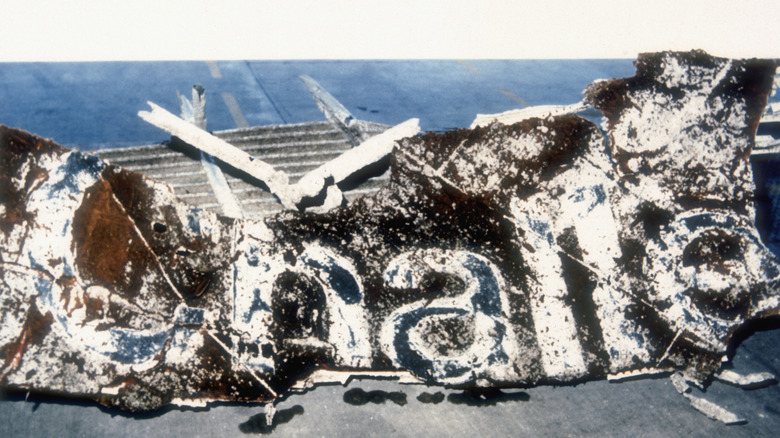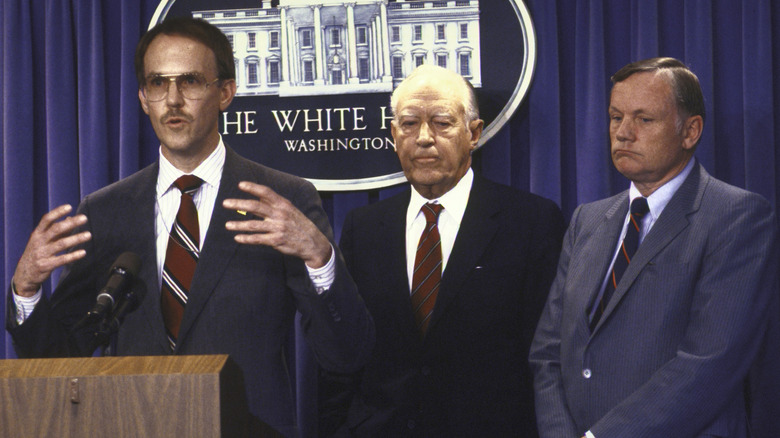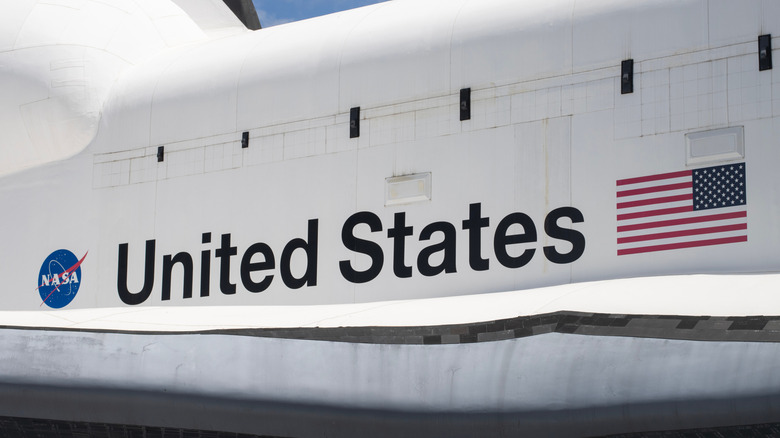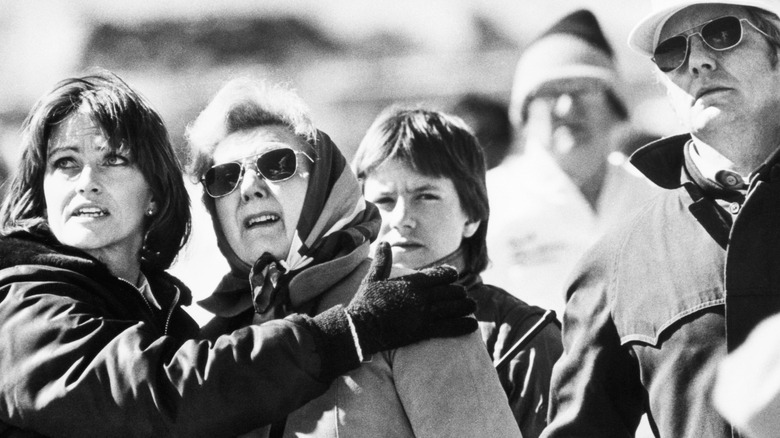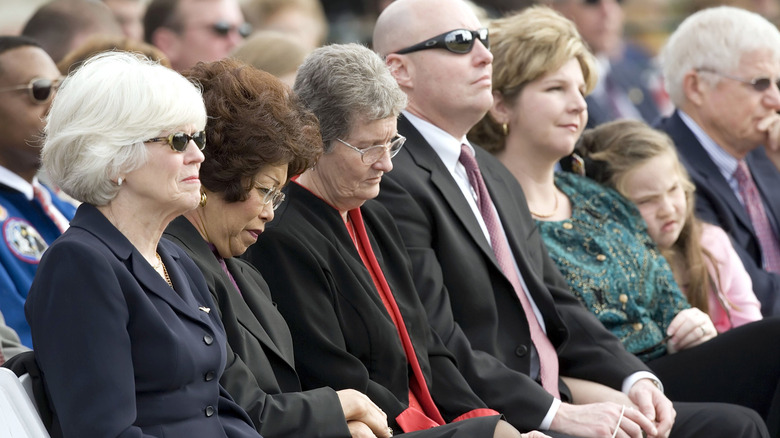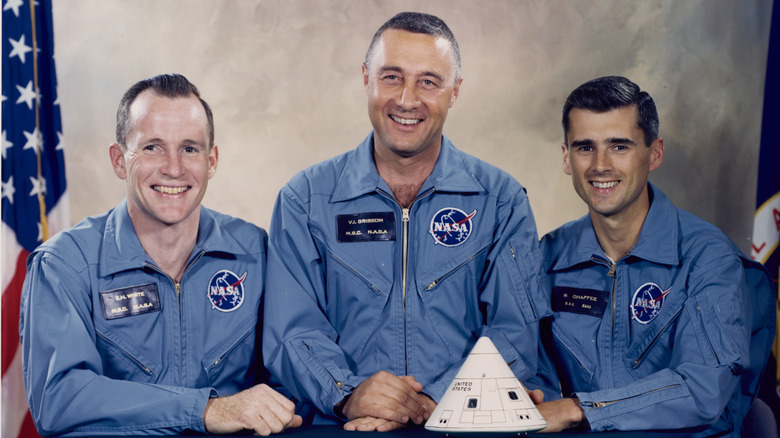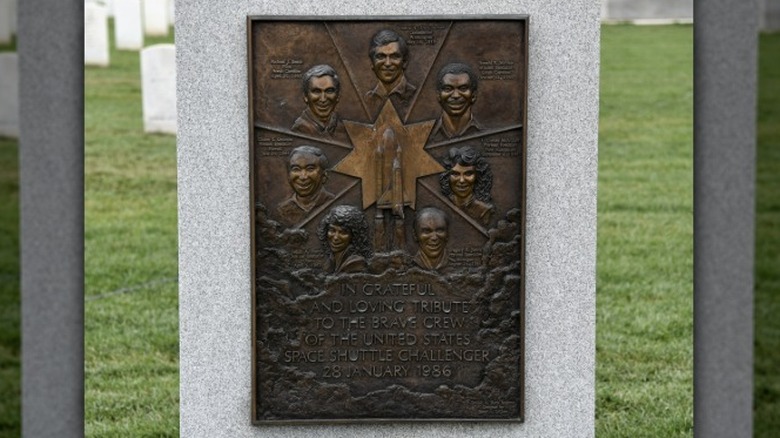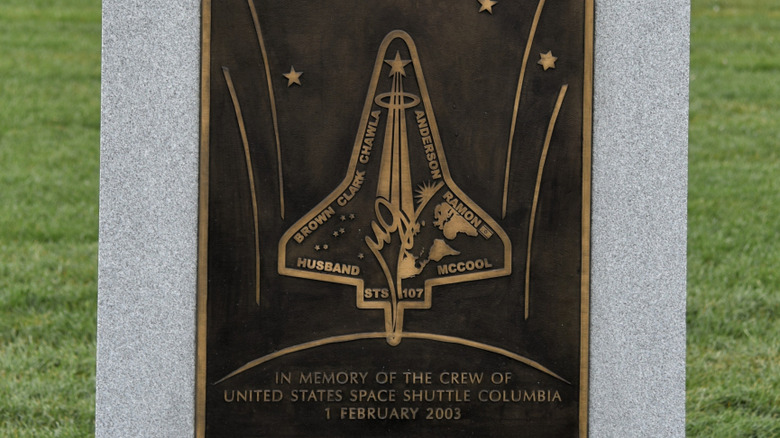The Worst Part Of The Space Shuttle Challenger Disaster Isn't What You Think
On the morning of January 28, 1986, the space shuttle Challenger lifted off from Florida's Kennedy Space Center. The shuttle program was in full swing in the mid-1980s, and NASA's latest mission appeared to be off to a fine start. But then, 73 seconds into the launch, the orbiter was engulfed in a fireball and torn apart, its pieces falling back to Earth. All seven of the astronauts on board — Dick Scobee, Ellison Onizuka, Judith Resnik, Mike Smith, Greg Jarvis, Ron McNair, and Christa McAuliffe — were killed in the disaster.
McAuliffe's death struck an especially poignant chord. She'd been the first teacher to ever be selected to go into space, and her death was witnessed live by her family, her students, and schoolchildren across the country. That's horrible enough, but as with many tragedies, there are further layers to the story. As you're about to see, the worst part of the Space Shuttle Challenger disaster may not be what you think.
NASA knew about the O-ring problems well in advance
Challenger was destroyed due to a faulty O-ring seal in one of its booster rockets, allowing burning gas to escape. The rubber O-rings, of which there were a primary and secondary between each rocket segment, weren't supposed to be burned by the gases resulting from liftoff, but that's exactly what happened during the testing phase. Shockingly, according to the Rogers Commission Report, when it was found that the O-rings could be damaged, engineers at both NASA and Morton Thiokol, the company contracted to design and build the rockets, decided that the situation was undesirable but acceptable.
A test in 1977 revealed another ominous problem — rocket ignition could cause parts of the rocket's steel casing to bend outward, reducing the pressure on the O-rings. The opposite was supposed to happen, with parts bending inward and helping the O-rings to seal properly. At this point, engineers began to sound the alarm. One characterized the current design as "unacceptable" in October 1977, and another stated in January 1978 that a redesign was necessary to "prevent hot gas leaks and resulting catastrophic failure." Despite this, nothing was changed.
NASA had more than theory to go on after its second shuttle mission, when Columbia flew in November 1981. When they recovered and examined the shuttle's right rocket booster, one of its primary O-rings had been eroded badly, news that was ultimately met with no action. Multiple subsequent shuttle missions during the 1980s showed O-ring damage, yet still, the design wasn't changed.
The Challenger launched despite warnings about the cold
By 1985, engineers at Morton Thiokol had another concern about the O-rings, namely that they would lose elasticity in cold weather. Given that NASA's bevy of planned shuttle missions included winter launches, this was a problem. One of the engineers, Bob Ebeling, wrote a memo in October 1985 (via NASA Space Flight) and titled it "Help!" in the hope of finally drawing attention to the issue. No help came.
On January 27, 1986, NASA called Morton Thiokol and asked how they felt about a launch in 18-degree weather. The engineers were aghast. The O-rings' lower threshold of safety was 40 degrees Fahrenheit. Ebeling called his team together, and they all agreed that a launch in such a temperature would be the death of the shuttle crew. In a teleconference with NASA, the engineers laid out why Challenger should not be launched the next morning and recommended that it not lift off in any temperature lower than 53. As engineer Roger Boisjoly later recounted (via NPR), a NASA official was "appalled" at the thought of waiting so long to launch.
The clear, cold weather that night led to ice forming all over the launch pad, but NASA decided to proceed. The crew were told about the ice when they were briefed on the weather that morning, but they weren't told about any concerns regarding the temperature's effect on the O-rings. The mission was a go.
The Challenger would've lifted off in better conditions if not for a string of delays
Challenger's launch was scrubbed repeatedly for one reason or another. Had even one of those delays not occurred, the shuttle might've lifted off in safer temperatures. First, it was moved from January 22 to January 23 due to schedule ripples caused by the prior delay of another mission, STS-61-C, and then the Program Requirements Change Board moved liftoff to January 25. After that, the aftereffects of STS-61-C's delay bumped Challenger again to January 26.
The evening before the new launch date, the mission was pushed off yet again due to a forecast of wind and rain, which turned out to be entirely wrong. As Gene Thomas, launch director for the Challenger mission, later recalled (via NASA Space Flight), "We decided we would not launch on Sunday, and Sunday was a beautiful day. We missed an opportunity to launch."
Challenger's crew were strapped in and ready to go on the morning of January 27 when another problem reared its head. A screw wouldn't release from the shuttle's crew hatch. A drill was brought in, but its battery was dead. Nine more batteries were brought to the launch pad, and for reasons unknown, every single one went dead. Liftoff was finally pushed back one more time ... to the very cold morning of January 28.
A brief glimmer of false hope
At 11:39 a.m. on January 28, Challenger launched from Kennedy Space Center on what would be a short, doomed flight. Footage later showed that dark smoke began to jet from one of the right-side solid rocket booster's (SRB's) O-rings less than a second after liftoff began. The shuttle broke the sound barrier 40 seconds up, and at around 59 seconds, a plume of flame began to issue from the right-hand SRB. The crew wouldn't have known about this, as further evidenced by their yells of "Wooooo hooooo!" at 60 seconds, a mere quarter-second before the flame began to contact the orbiter's massive external fuel tank. Even if the crew had known what was happening, there was nothing they could've done.
Just before 73 seconds came the last words from Challenger, spoken by Mike Smith: "Uh-oh." Immediately afterward, the shuttle was torn apart as the external fuel tank erupted into a massive fireball. A few seconds later, an object was seen descending slowly via parachute. Several TV stations began to focus on footage of the object in the shock and confusion that followed. However, it was only the nose cap of one of the SRBs.
The Challenger crew never could've escaped
Anyone in the know wouldn't have focused on the parachuting nose cap for long because there was no way for the Challenger crew to have escaped from the shuttle. The first shuttle, Columbia, had ejection seats similar to those of an SR-71 Blackbird for its four test flights early on, but that was when only two people were flying. The seats were never meant to be in place for the actual shuttle missions, when it was assumed that all risks would've been accounted for and resolved.
NASA had, in fact, considered full crew ejection options back in 1971 when the shuttle was being designed, examining the feasibility of conventional ejection seats, encapsulated seats, and a whole detachable crew compartment. The problem was the cost of integrating any of these options into the design. Open seats would've cost $10 million, encapsulated seats would've cost $7 million, and the crew compartment option would have added a whopping $292 million to the bill. After the Challenger disaster, the idea of an astronaut escape system was examined once again. A number of designs were considered, but as before, all of them were ultimately rejected due to the difficulty of their implementation.
The grim recovery
Recovery efforts began within an hour of Challenger's breakup, but the crew wouldn't be found until March 1986. Off the Florida coast, two divers came across the crew cabin on the seabed approximately 100 feet below the surface. It was a wreck of twisted metal and wires, and the divers didn't know what they'd found until they saw a spacesuit bobbing in the water. Low on air, the two men marked the location and swam for the surface.
The next day, the USS Preserver came to recover the lost astronauts, but that was easier said than done. Between the crash and the time spent underwater, their remains weren't in good shape, having at times to be removed in parts. First, Judy Resnik was recovered, followed by Christa McAuliffe. After this, it was determined that the jagged, jumbled cabin would have to be raised from the ocean in order to continue.
As a crane pulled the cabin to the ship, a splash of blue appeared on the surface. It was the jump-suited body of Gregory Jarvis, which had come free as the cabin was raised. As the crew of the Preserver watched in dismay, it sank below the waves again. A search for Jarvis immediately ensued, during which astronaut Robert Crippen even hired his own boat to help, but Jarvis wouldn't be found again for another five weeks, 200 yards from where he'd been lost.
The engineers who tried to stop the launch blamed themselves
After failing to convince NASA to stop Challenger's January 28 launch, Morton Thiokol engineer Roger Boisjoly went home. Upon being asked by his wife what was wrong, he responded, "Oh nothing, hunny, it was a great day, we just had a meeting to go launch tomorrow and kill the astronauts, but outside of that, it was a great day" (via NASA Space Flight). Boisjoly, fearing the worst, had no intention of watching the launch, but fellow engineer Bob Ebeling convinced him to do so. When the shuttle seemed to lift off just fine, a wave of relief washed over the engineers ... until they saw the fireball. Everyone present knew just what had happened.
Despite his efforts, Boisjoly felt responsible for the seven astronauts' deaths, as did Ebeling. Over the following months, the once-bulky Boisjoly lost quite a bit of weight and became plagued by headaches, insomnia, and depression. He testified to the Rogers Commission and also sued both NASA and Morton Thiokol. However, his lawsuits weren't successful, and Boisjoly's actions led to his shunning by some of his colleagues, worsening his despair. Boisjoly did eventually find peace, however, through speaking to engineering schools about the disaster, which he continued to do until his death in January 2012.
The Challenger crew may have been conscious as they fell to Earth
According to a report by NASA scientist Joseph P. Kerwin, when the Challenger broke apart, its crew, protected by the cabin, wouldn't have been killed or even seriously injured, a fact which begs a somber question: Were they still conscious as they fell toward the sea? The answer is unclear.
After the orbiter was torn apart, the sturdy crew cabin (pictured) began to free fall. The central question is how quickly the cabin depressurized. If it did so right away, the astronauts would've been mercifully unaware of their descent after only a few seconds. On the ocean floor, the cabin was a mangled mess, but that was due to its impact. Given the damage, it couldn't be determined whether there'd been any breach in the cabin before the crash.
There is one chilling indicator of the crew's fate. Of the four personal egress air packs, or PEAPs, that were recovered, three had been activated before the impact. However, Kerwin noted that the PEAPs may have been activated "instinctively" due to depressurization right at breakup, in which case they wouldn't have kept the astronauts awake, as they only provided regular air. For what it's worth, per NBC News, three-time shuttle commander Robert Overmeyer, who participated in the cabin's recovery, is certain that the Challenger astronauts were conscious. Whatever happened, there was no chance of survival when the cabin struck the ocean at 207 miles per hour.
Before the disaster, Challenger had nine successful flights
Challenger began life as STA-099. Built by now-defunct aerospace manufacturing company Rockwell International from 1975 to 1978, STA-099 was a grounded test vehicle designed to confirm if lighter shuttles could indeed be viable for actual spaceflight. This was necessary because back then, technology had not yet progressed to the point where computer models could accurately tell how the resulting heat and stress of space travel would impact such vehicles.
After about a year of thermal and vibration tests inside a customized rig for simulating all the stages of spaceflight, Rockwell conducted an extensive reworking of STA-099 (which included wing reinforcements and building a proper crew cabin and heads-up displays for astronauts), completing the test vehicle's conversion to a functional spacecraft in 1982. By that time, it was formally called "Challenger," taking its name from a pioneering 19th-century research ship and joining Columbia in NASA's roster of orbiters.
While the ill-fated 1986 mission is what most people remember Challenger for, it's important to note that it had nine prior spaceflight missions, all of which were successful. Its first mission took place on April 4, 1983; on its second mission on June 18, 1983, its five-member crew included Sally Ride, the first American woman to fly in space. It completed a third flight in 1983, three missions in 1984, and another three in 1985. The fact that these were all successful made its 10th and final mission all the more shocking and unexpected — for most of the world, at least.
The tragedy overshadowed Challenger's many noteworthy accomplishments
Challenger spent a combined total of over 69 days in space and successfully orbited the Earth 87 times over the course of three years. As the second of NASA's then-growing spacecraft fleet, Challenger became a pioneering vehicle, with its missions establishing many notable firsts.
Its maiden flight in 1983 made the space shuttle program's first spacewalk possible; additionally, Challenger carried as its payload a Tracking and Data Relay Satellite, the first in a system that would revolutionize spacecraft communications worldwide. In addition to being the first space-faring American woman, Sally Ride, part of Challenger's second mission (STS-7), was also the youngest American in space at the time. The third mission, STS-8, featured the space shuttle program's first night launch and landing, as well as the first African-American in space, Dr. Guy Bluford. Challenger's subsequent missions continued to set records, including the first untethered spacewalk in 1984 and the largest crew on a single space shuttle mission in 1985.
For some, it was like watching a slow-motion train wreck
Experts have said much about how the Challenger space shuttle explosion could have been avoided. In reality, there were warning signs in the years leading up to the mission — and for some who were in the know, the doomed flight cast a bleak shadow upon them, even long after the tragedy.
On the day of the launch, it was a chilly 36 degrees Fahrenheit, which engineers deemed could be cold enough to prevent the rocket boosters' rubber O-rings — designed to stop hot gases from escaping the boosters — from working properly. Instead of rescheduling, however, NASA just waited for the launchpad to defrost before continuing. Sure enough, gases leaked out (visible as black smoke in the launch footage), resulting in the shuttle's destruction. It's worth noting that problems concerning O-ring deterioration had reportedly been known since the 1970s; in fact, Challenger experienced a similar cold-related O-ring malfunction during a launch one year earlier.
The engineers warned the agency about the potential catastrophe, to no avail. Less than a month after the disaster, booster rocket engineer Roger Boisjoly declared to NPR: "I fought like Hell to stop that launch. I'm so torn up inside I can hardly talk about it, even now." And in a 2016 interview with NPR, Boisjoly's fellow engineer Bob Ebeling candidly admitted that what transpired still haunted him, even after 30 years. "Had [NASA] listened to me and wait[ed] for a weather change, it might have been a completely different outcome."
Opportunists tried to make money off of the tragedy
How much of the space shuttle Challenger is still lost in the ocean? As of 2022, NASA has recovered approximately 47% of Challenger debris. Many of the fragments now reside at the Cape Canaveral Space Force Station in Florida, stored in abandoned missile silos. It's possible that somewhere out there, divers and beachwalkers are still finding pieces and chunks of the spacecraft. But it's important to know that if this ever happens to you, "finders keepers" does not apply in this situation — and you could be facing serious charges, should you insist otherwise.
Aside from being in horribly poor taste, possession and selling of a Challenger artifact is a violation of Title 18, U.S. Code Section 641 and punishable by law. At least one auctioneer has learned this the hard way. According to collectSpace, Charles Starowesky was among the first responders sent by the U.S. Coast Guard to recover debris at the Challenger site. Reportedly, Starowesky pocketed a thermal tile from the wreckage and kept it for 13 years, deciding to make money off of it by posting it on eBay. The government found out; he was sentenced to two years of probation, which could have been much worse (up to 10 years in prison and a $10,000 fine).
Ambition and pressure may have gotten in the way of common sense
If there were any suspicions that the Challenger disaster was a result of malicious intent or organizational malpractice, the subsequent government investigation laid all of those to rest. Nevertheless, identifying the root (non-technical) cause of the tragedy was a difficult endeavor; after all, if everyone followed NASA's established rules, then the colossal mishap should not have happened.
But as it turned out, the agency's protocols themselves may have been questionable. As reported by the U.S. Committee on Science and Technology in October 1986, "NASA's drive to achieve a launch schedule of 24 flights per year created pressure throughout the agency that directly contributed to unsafe launch operations." The Committee also noted that even after the catastrophic launch, this "pressure to push" was still observed in other aspects of NASA's operations, which led to safety concerns taking a backseat instead of being rightfully prioritized.
That said, the blame may not rest solely on NASA's shoulders. In a 2006 talk at the University of Tennessee Space Institute, Allen J. McDonald, project director of the ill-fated Challenger mission, shared that the Reagan administration had been adamant that NASA continue the launch, despite the less-than-ideal circumstances pointed out by its experts. In a cruel twist, Challenger's loss became a massive blow to the U.S., stressed McDonald: "[Challenger] was our key [space] vehicle, and the Cold War was still going on in 1986, and we had lost every major launch vehicle we had within a year."
It sent the Space Shuttle program to a grinding halt
The U.S. government's response to the Challenger disaster was swift: just six days after the tragedy, President Ronald Reagan ordered the assembly of a special investigative committee to probe deeper into it. The Rogers Commission, led by former Secretary of State William Rogers, included notable figures in aeronautics and aviation, including astronauts Sally Ride and Neil Armstrong, as well as theoretical physicist Richard Feynman. Their finalized report was damningin its criticism of NASA, and led to the space shuttle program being put on hold for 32 months. In particular, Feynman's assessment of NASA's program was so sharp and scathing, with such choice words as "the management of NASA exaggerates the reliability of its product, to the point of fantasy" that it was shunted to the back of the report as an appendix.
NASA formally resumed the program's operations on September 29, 1988, when the agency sent space shuttle Discovery on its seventh mission. Despite this seemingly triumphant return, it would eventually become clear that it was not meant to last. According to the investigation report about the 2003 space shuttle Columbia disaster, "despite all the post-Challenger changes at NASA and the agency's notable achievements since, the causes of the institutional failure responsible for Challenger have not been fixed." The committee also noted "persistent, systemic flaws" that, if not fixed, would make another tragedy inevitable. (Here's why NASA was never the same after the Challenger disaster.)
NASA's crisis communication strategy was a disaster in itself
NASA's approach to publicly sharing information about the Challenger disaster could perhaps be best described as tight-lipped. In an analysis of NASA's post-Challenger communications, members of the U.S. Department of Defense noted that there was a "lack of information" from the agency at the time; as a result, this affected the American public's confidence in NASA. A month after the disaster — and after it had become public knowledge that NASA leadership okayed the launch despite engineers' warnings — the Los Angeles Times polled 2,241 Americans, with half of them saying that the agency made "serious errors in judgment" and 57% stating that they would not participate in future space missions as citizen astronauts.
Meanwhile, in a 2005 paper in Public Relations Review, authors analyzed 100 stories published in major U.S. newspapers in the week after the Challenger disaster. They noted that in about a fifth of those articles, NASA was portrayed as having "an inadequate flow of information" about the incident (e.g., failing to answer questions or simply responding with "No comment"). Additionally, NASA's leaders were said to be typically unavailable to talk to the media; some articles even described NASA as "inaccessible" and "not credible in its communications."
For what it's worth, NASA appeared to have taken the communication lessons they learned from Challenger to heart. The authors observed that in the media blitz following the Columbia disaster 17 years later, the agency generally received more positive news coverage, and its representatives were portrayed as "more open, accessible, and prepared."
The crew's family (and students nationwide) were left traumatized
The Challenger disaster ended the lives of its crew and broke the lives of those they left behind. Amid talks of legal action, a settlement was reached, with both the U.S. government and Morton Thiokol, the contractor that built Challenger's rocket boosters, paying millions of dollars to the bereaved.
But no amount of money could bring back loved ones lost. ”There hasn't been [an] hour in the day that I haven't thought of him in some way,” Ronald E. McNair's son, Carl, told The New York Times in 1987. Speaking to Popular Mechanics in 2022, Dick Scobee's daughter, Kathie, shared that she had nightmares about her father lost somewhere in the Atlantic Ocean, marooned on Challenger debris. In a 2021 interview with Today, Scobee's widow, June, revealed that the Challenger crew's families bonded over their shared grief, remaining close decades after the tragedy. She described the media coverage of the Challenger disaster as "unbearable," with their grief constantly displayed in news reports.
One of the myths you shouldn't believe about the Challenger disaster is that the entirety of America witnessed it live. Instead, what many saw were taped replays. However, approximately 2.5 million students watching from their schools saw the tragedy as it unfolded, with millions more catching the replays. A 1999 study in The American Journal of Psychiatry found that children in California and New Hampshire who were tuned in exhibited PTSD symptoms weeks after the incident, with over 60% still suffering effects nearly two months after the incident.
It happened a day after the anniversary of another space mission tragedy
One chilling fact about the Challenger tragedy was that it happened a day after the anniversary of one of the biggest disasters in space history: The deaths of the astronauts who would have been in the first manned Apollo mission.
On January 27, 1967, the crew of Apollo 204 (aka Apollo 1) — Virgil "Gus" Grissom, Edward White, and Roger Chaffee — perished during a test run at Launch Complex 34 in Cape Kennedy, in preparation for its launch one month later. The spacecraft's command module caught fire, with the astronauts trapped inside. Initially, Grissom detected a "sour smell" after hooking up to his oxygen supply, but the crew determined it was okay to continue. Another issue emerged when elevated oxygen flow triggered the master alarm, but it was determined to be caused by the astronauts' movements inside the shuttle (meaning the test could still proceed). Then, communication glitches disrupted their countdown; by the time the control room was ready to resume, the cockpit caught fire. Sadly, the astronauts could not escape in time, succumbing to carbon monoxide asphyxia and cardiac arrest before technicians could successfully pull them out.
Engineer John Tribe, who built the Apollo capsule, told Popular Mechanics that the fire happened because of "trying to go too fast," which he likened to the pressure surrounding Challenger's launch. "In our business, it's when you don't do things in a carefully conducted manner that you start to get into trouble."
It took almost 20 years for them to receive Medals of Honor
A memorial for the Challenger crew stands in Section 46 of Arlington National Cemetery's Memorial Amphitheater. The marker, which features the engraved names and faces of the crew, was built in 1987. But while there has been no shortage of appreciation and respect given to Dick Scobee and his team over the years, it's not surprising to wonder why it took 18 years for them to receive arguably one of, if not the most, prestigious testaments to their contributions to space science: the Congressional Space Medal of Honor.
According to NASA, the medal is awarded, under the endorsement of the U.S. president, to an astronaut who "in the performance of his duties has distinguished himself by exceptionally meritorious efforts and contributions to the welfare of the Nation and of mankind." It wasn't until 2004 that the seven astronauts who died during the Challenger mission would receive their medals, endorsed by President George W. Bush. It is unclear why it took so long for the Challenger crew to be awarded; perhaps the process of selection and verification is just that thorough and extensive. As an aside, the Apollo 1 crew, who perished in 1967, posthumously received their Medals of Honor on different dates: Gus Grissom was among the first batch of awardees in 1978, while Edward White and Roger Chaffee received theirs in 1997.
It was not the last Space Shuttle disaster
Challenger's tragic 10th mission was unfortunately not the last time disaster would fall upon the space shuttle program. On February 1, 2003, the 28th mission of space shuttle Columbia — the first spacecraft in NASA's fleet to fly to space, even before Challenger — ended in catastrophe. During its return trip from a 16-day research mission, the vehicle disintegrated upon re-entry, leading to the deaths of its seven-member crew.
As with the Challenger disaster, this tragedy prompted NASA to suspend its space shuttle program once more; this time, the hiatus lasted for over two years. An in-depth investigation revealed that the seeds of Columbia's destruction had been inadvertently planted a mere 82 seconds into its flight: a sizable piece of insulating foam attached to its external tank had actually fallen off, damaging its left wing. The resulting hole enabled superheated atmospheric gases to penetrate during the shuttle's re-entry, destroying the wing from the inside and compromising the vehicle's structural integrity. The worst part? According to the Columbia Accident Investigation Board's report, NASA had already been aware of this problem for years: "With each successful [space shuttle] landing, it appears that NASA engineers and managers increasingly regarded the foam-shedding as inevitable, and as either unlikely to jeopardize safety or simply an acceptable risk."
This proved to be the final nail in the coffin for NASA's space shuttles. By July 2011, after completing a handful of missions geared toward finishing the International Space Station, the program ended its 135-mission run.
